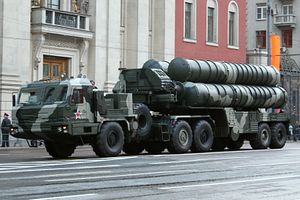Russian state-owned arms maker Almaz-Antey has delivered a new S-400 Triumf advanced Air Defense System (NATO reporting name: SA-21 Growler) regiment to the Russian armed forces ahead of schedule, the company said in an August 27 press statement.
“Almaz-Antey Group has delivered a new regiment set of S-400 Triumf surface-to-air missile systems to the Defense Ministry of Russia ahead of schedule. The official ceremony was held at the Kapustin Yar training range in the Astrakhan Region,” the statement reads without naming a specific date.
“In compliance with the Defense Ministry’s requirements, the systems were tested by engaging real air targets during their transfer. The delivery/acceptance tests were performed successfully.”
The new unit brings the total number of deployed S-400 regiments currently in service with the Russian armed forces to 25, according to a Diplomat count. The Russian military is expected to receive at least three additional S-400 regiments by the end of 2020. The last S-400 regiment was delivered to the military in July. As I explained that month:
A S-400 regiment is divided up into two battalions (also called divisions in the Russian military), which in turn are split into two batteries. A battery can consist of up to 12 transporter erector launchers (TELs), although 4 to 8 TELs per unit are more common. In addition to the TELs, each battery includes a long-range surveillance radar, target acquisition and engagement (fire control) radar systems and a command post, as well [depending on the unit composition] as an additional fire control radar system.
The S-400 air defense system, capable of engaging up to 36 targets simultaneously, can be armed with a host of different missiles as I explained previously:
In comparison to its predecessor, the S-300, the S-400 air defense system features an improved radar system and updated software; it can purportedly fire four new types of surface-to-air (SAM) missiles in addition to the S-300’s 48N6E, a vertical tube launched, solid fuel, single stage SAM with an estimated range of 150 kilometers (93 miles), and the improved 48N6E2 missile with a reported range of 195 kilometers (121 miles).
(…)
The S-400 is also armed with an improved variant of the 48N6E2 with an alleged range of 250 kilometers (160 miles). The air defense system can also fire two additional missiles, the 9M96E and 9M96E2 with respective ranges of 40 km (25 miles) and 120 km (75 miles). Improved S-300 air defense systems such as the S-300PMU-2 Favorite … can purportedly also fire the 9M96E and 9M96E2.
The S-400 latest and most advanced missile system, the 40N6 SAM (the export variant of the missile is designated 40N6E), is expected to be declared operational in the coming weeks. The missile has been undergoing operational evaluation and testing throughout the summer, with first missile deliveries expected in the fall. (According to some reports, the 40N6 passed its final set of trials already in July.)
Almaz-Antey, during this month’s 2018 Army Forum, an annual event organized by the Russian Ministry of Defense to showcase Russian-made military hardware, for the first time released official figures of the export variant of the 40N6. According to the information provided at the event, the 40N6E, with a maximum altitude of 30 kilometers, is not capable of exo-atmospheric interception of intermediate-range ballistic missile warheads in their terminal phase or satellites.
































